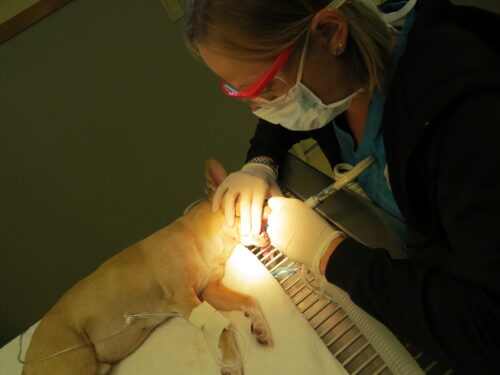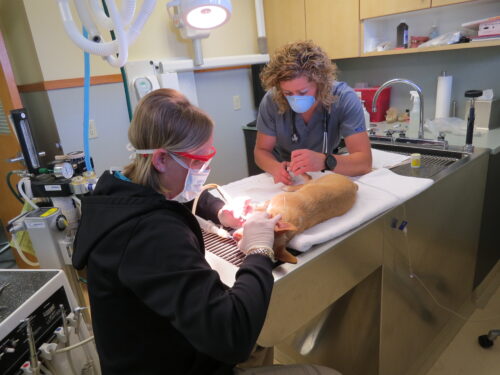The majority of cats and dogs over the age of 2 have some form of dental disease. During your regular wellness and vaccination exams Dr. Neumeister will take a close look at your pet’s gums, and check the teeth for plaque and tartar, oral infections, bad breath, and other problems. This is important because the signs of disease can be subtle at first. Oral disease will affect the overall health of your pet greatly. Especially heart-, liver- and kidney disease can be the result of bacteria from bad teeth.

Some dogs (usually small breeds) can require a dental up to every 6 months. Other dogs can go 3 to 4 years between dental cleanings. Typically, after the age of 2 or 3, most dogs and cats will need a dental every 1 to 2 years. Dr. Neumeister may recommend a particular dental cleaning schedule, oral care routine, or special treatment based on your pet’s dental health needs.
If you notice any of the following signs in between your pet’s regular wellness exams call us at 563-582-8417 to make an appointment:
 Generally, dental cleaning, as well as oral surgery (extractions), are outpatient procedures. We ask that you withhold food after 8 PM or 9 PM on the day before the procedure. You can either drop your pet off at 8 AM on the day of the procedure, or you can stay during the initial sedation process.
Generally, dental cleaning, as well as oral surgery (extractions), are outpatient procedures. We ask that you withhold food after 8 PM or 9 PM on the day before the procedure. You can either drop your pet off at 8 AM on the day of the procedure, or you can stay during the initial sedation process.
The dental cleaning will usually be performed in the morning and in most cases, the patient will be able to go home in the afternoon. Even pets receiving advanced oral surgery, such as extractions will be able to go home on the same day.
A physical examination and pre-surgical blood work for each of our patients is done prior to placing them under anesthesia. The blood work will help to rule out any pre-existing internal problems that may not be evident physically.
Our team monitors each patient throughout the dental procedure to ensure the patient is responding appropriately to the anesthesia. This includes manual monitoring, electronic monitoring, IV catheter, intravenous fluids, antibiotics, and pain medication. We use very safe anesthetics and monitor your pet in our recovery kennels afterward.
(Warning: the photos below show dental disease. Please do not scroll down if this makes you uncomfortable)
To reduce dental disease and help your pet live a healthy life we recommend: